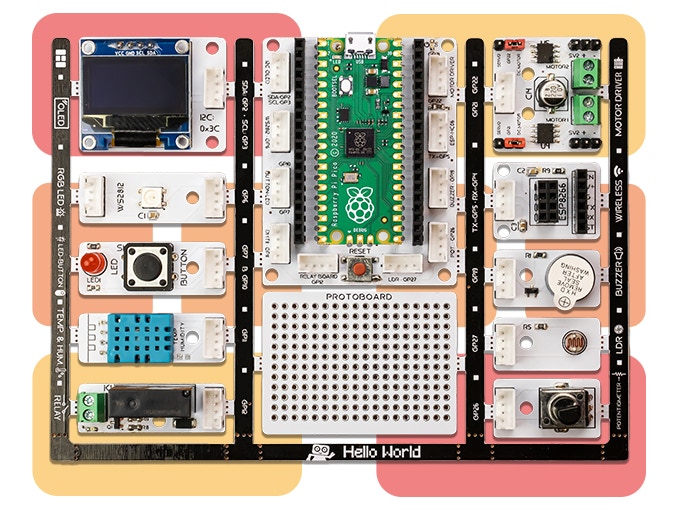
The Next Generation of STEM: A Deep Dive into the Latest Robot Kit News and Trends
The Dawn of a New Era in Hands-On Learning
The world of educational toys is undergoing a seismic shift. Gone are the days of simple, single-function electronic toys. Today, we are witnessing the rise of sophisticated, programmable, and intelligent robot kits that are transforming how we approach STEM (Science, Technology, Engineering, and Mathematics) education. This new generation of tools is more than just a passing trend; it represents a fundamental change in interactive learning, blending the tangible satisfaction of building with the limitless potential of coding and artificial intelligence. The latest Robot Kit News isn’t just about new products; it’s about a movement that is democratizing robotics, making it accessible and engaging for students, hobbyists, and future engineers. These kits serve as a crucial bridge between abstract digital concepts and real-world physical applications, fostering critical thinking, problem-solving skills, and creativity. As we delve into the latest AI Toy Innovation News, we see a clear trajectory towards more modular, powerful, and user-friendly platforms that are setting a new standard for what an educational toy can be.
What’s Driving the Innovation in Educational Robotics?
Several key technological advancements are converging to fuel this explosion in advanced robotics for learning. The latest STEM Toy News highlights a departure from closed, proprietary systems towards open, flexible platforms that encourage experimentation and growth. This shift is powered by three core pillars: powerful microcontrollers, modular design philosophies, and sophisticated software ecosystems.
The Microcontroller Revolution: More Power, Less Cost
At the heart of every modern robot kit is its “brain”—the microcontroller unit (MCU). We’ve seen a dramatic evolution from the classic 8-bit MCUs to powerful, 32-bit dual-core processors like the Raspberry Pi Pico and the ESP32. This leap in processing power, available at an incredibly low cost, has been a game-changer. Where older kits could only handle simple sequential commands, new ones can run multiple processes simultaneously, manage complex sensor data, and even run lightweight machine learning models directly on the device. This is central to the latest Programmable Toy News, as it allows for more complex and responsive behaviors. A robot can now use one core to manage motor control for precise movement while the other core analyzes data from a camera sensor, enabling real-time object recognition—a task unthinkable for an educational kit just a few years ago.
The Power of Modularity and Expandability
The most exciting Modular Robot Toy News centers on the concept of “plug-and-play” hardware. Instead of complex wiring and soldering, modern kits often feature standardized connectors that allow users to easily snap on a wide array of sensors, motors, and other peripherals. This approach, reminiscent of advanced Robot Building Block News, significantly lowers the barrier to entry. A beginner can start with a basic chassis and a distance sensor, while an advanced user can augment the same core robot with a camera, a robotic arm, an IMU (Inertial Measurement Unit), and custom 3D-printed parts. This fosters a scalable learning curve and encourages personalization, a key theme in AI Toy Customization News. This design philosophy not only makes the kits more versatile but also extends their lifespan, as they can grow with the user’s skills.
Sophisticated Software and AI Integration
Hardware is only half the story. The user experience is defined by the software. Leading platforms now offer a dual-coding environment. Beginners can start with a visual, block-based language like Scratch or Blockly, which makes programming logic intuitive and accessible. As their confidence grows, they can seamlessly transition to text-based programming in industry-standard languages like MicroPython or C++. This guided progression is a cornerstone of modern Coding Toy News. Furthermore, the latest AI Toy App Integration News showcases how these kits are being paired with powerful applications that simplify the process of training and deploying simple AI models. A user might use a smartphone app to collect images of different objects, train a classification model in the cloud, and then deploy it to their robot, which can then sort objects by color or shape. This makes abstract AI concepts tangible and exciting.

Anatomy of a Modern Robot Kit: A Technical Breakdown
To truly appreciate the advancements, it’s essential to look under the hood. A modern robot kit is a symphony of interconnected components, each playing a crucial role in bringing the creation to life. Understanding these parts is key to evaluating the latest AI Toy Prototypes News and making informed decisions.
The “Brain”: Core Processing Units (CPUs)
The choice of CPU dictates the robot’s capabilities. Let’s compare two popular options:
- Raspberry Pi Pico: A low-cost, power-efficient microcontroller. It excels at real-time control of motors and sensors (a key topic in AI Toy Sensors News). It’s perfect for tasks like line-following robots, balancing robots, or robotic arms where precise and immediate responses are critical. It typically runs MicroPython or C++.
- Raspberry Pi 4/5: A full-fledged single-board computer (SBC) running a Linux operating system. It offers significantly more processing power, RAM, and connectivity options (Wi-Fi, Bluetooth, USB). This makes it ideal for more complex projects involving computer vision, running a web server, or processing large amounts of data. It’s the brain you’d want for a smart AI Vehicle Toy News feature like autonomous navigation using a camera feed.
The trend is towards kits that are compatible with both, allowing users to start with a Pico and upgrade to a full Pi as their ambitions grow.
Sensors and Actuators: The Senses and Muscles
A robot is only as smart as the data it can collect and the actions it can perform. The variety of available modules is a frequent highlight in AI Toy Accessories News.
- Common Sensors: Ultrasonic sensors for distance measurement, infrared (IR) sensors for line following and remote control, color sensors for object sorting, and IMUs for orientation and stabilization. More advanced kits are now including camera modules for AI vision and microphones for voice commands, reflecting the latest Voice-Enabled Toy News.
- Common Actuators: DC motors for wheels, high-torque servo motors for robotic arms and grippers, and stepper motors for precise, repeatable movements like those needed in an AI Drawing Toy News project. The quality and precision of these components directly impact the robot’s performance.
Connectivity, Power, and Community
Wireless connectivity is now a standard feature. Wi-Fi and Bluetooth allow for remote control via a smartphone app (a major topic in Remote Control AI Toy News) and enable IoT (Internet of Things) projects where the robot can interact with web services or other smart devices. Efficient battery management is also crucial for portability. Beyond the hardware, the strength of the community is a vital component. Active forums, detailed tutorials, and shared project libraries are invaluable. The best AI Toy Platform News often comes from companies that foster a vibrant ecosystem, which is a great indicator of a product’s long-term viability and support, a subject of interest in AI Toy Community News and AI Toy Tutorials News.
From Classroom to Living Room: Real-World Impact and Applications
The true measure of these kits is their impact on learning and creativity. They are breaking down the barriers between disciplines and creating new avenues for exploration in both formal and informal educational settings.

Revolutionizing STEM Education
In the classroom, these kits provide a tangible platform for teaching abstract concepts. A teacher can explain a ‘for loop’ in Python, but the concept truly clicks when a student uses it to make a robot’s wheels turn exactly ten times. A physics lesson on angles and velocity becomes far more engaging when applied to programming a catapult on a robotic arm. This hands-on approach caters to diverse learning styles and makes complex subjects more approachable. The latest Educational Robot News is filled with case studies of schools integrating these kits into their curricula, leading to increased student engagement and a deeper understanding of core STEM principles. This is where topics like AI Science Toy News and AI Learning Toy News come to life.
The Hobbyist and Maker Movement
For hobbyists, these kits are not an endpoint but a starting point. They serve as a reliable base platform for much more ambitious projects. A maker might use a kit’s chassis and motor controller but add a custom 3D-printed enclosure and a specialized sensor for a unique application, like an autonomous garden-weeding robot or an interactive Robotic Pet News-worthy companion. The open-source nature of many kits, a frequent topic in Toy Factory / 3D Print AI News, empowers this creativity. This community of makers pushes the boundaries of what’s possible, often sharing their innovations and contributing to the platform’s ecosystem, which is a source of constant AI Toy Research News.
Bridging the Digital-Physical Divide
Perhaps the most profound impact is how these kits bridge the gap between the code on a screen and a functioning object in the real world. This connection is magical and deeply motivating. It transforms programming from a passive, screen-based activity into an active, creative endeavor. Whether building a robot to solve a maze (AI Puzzle Robot News) or programming a sequence of movements and sounds for an AI Musical Toy News feature, users see the immediate physical results of their logical instructions. This feedback loop is incredibly powerful for building confidence and sustaining interest in technology.
Choosing the Right Kit: Best Practices and Recommendations

Navigating the burgeoning market of robot kits can be daunting. With so much AI Toy Brand News and competing claims, it’s important to approach the decision with a clear set of criteria.
Key Considerations for Parents and Educators
- Scalability: Does the kit grow with the user? Look for platforms that support both block and text-based coding and have a wide range of expansion modules.
- Community and Support: Is there an active online community? Are there well-documented tutorials and projects? Good support is more valuable than raw specs. Check for recent AI Toy Updates News to see if the platform is actively maintained.
- Durability and Safety: The kit will be built, taken apart, and rebuilt many times. Sturdy components are a must. For younger users, ensure compliance with safety standards, a critical aspect of AI Toy Safety News.
- Openness: Prioritize kits built on open-source hardware (like Raspberry Pi) and software. This prevents vendor lock-in and ensures long-term usability and customization options. This is a recurring theme in positive AI Toy Reviews News.
Common Pitfalls to Avoid
Be wary of kits with proprietary, closed ecosystems. While they may seem simpler at first, they often limit creativity and can become expensive as you need to buy specific, often overpriced, expansion modules. Another red flag is poor documentation. A powerful kit is useless without clear instructions and examples. Finally, consider the ethical implications, a growing concern in AI Toy Ethics News, especially for kits with cameras or microphones. Teach users about privacy and responsible use from the outset.
Conclusion: Building the Future, One Kit at a Time
The landscape of educational robotics is more vibrant and promising than ever. The convergence of affordable, powerful microcontrollers, modular design, and sophisticated, AI-enabled software has created a new generation of tools that truly empower learning and innovation. The latest Robot Kit News is not just for hobbyists; it’s a signal for parents, educators, and anyone interested in the future of technology. These kits are more than toys—they are comprehensive learning platforms that teach the fundamental skills needed for the 21st century: problem-solving, computational thinking, and creative engineering. By making complex technology accessible, engaging, and fun, they are not just building robots; they are building the next generation of innovators, thinkers, and creators. The ongoing AI Toy Trends News suggests this is only the beginning, promising even more integrated and intelligent learning experiences on the horizon.



